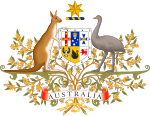 | |
| Australian Public Service overview | |
|---|---|
| Formed | 1 January 1901 |
| Headquarters | Canberra, Australia (39.1 per cent of staff)[1] |
| Employees | 170,332 (at December 2023)[2] |
| Australian Public Service executives | |
| Key document | |
| Minister for the Public Service | |
|---|---|
since 1 June 2022 | |
| Australian Public Service | |
| Style | The Honourable |
| Appointer | Governor-General on the recommendation of the Prime Minister of Australia |
| Inaugural holder | Mathias Cormann |
| Formation | 28 August 2018 |
The Australian Public Service (APS) is the federal civil service of the Commonwealth of Australia responsible for the public administration, public policy, and public services of the departments and executive and statutory agencies of the Government of Australia.[3] The Australian Public Service was established at the Federation of Australia in 1901 as the Commonwealth Public Service and modelled on the Westminster system and United Kingdom's Civil Service. The establishment and operation of the Australian Public Service is governed by the Public Service Act 1999 of the Parliament of Australia as an "apolitical public service that is efficient and effective in serving the Government, the Parliament and the Australian public".[4] The conduct of Australian public servants is also governed by a Code of Conduct and guided by the APS Values set by the Australian Public Service Commission.[5]
As such, the employees and officers of the Australian Public Service are obliged to serve the government of the day with integrity and provide "frank and fearless advice" on questions of public policy, from national security to fiscal policy to social security, across machinery of government arrangements.[6] Indeed, the Australian Public Service plays a major part in Australian life by providing "cradle to grave" services with a degree of shared responsibility with the State and Territory governments.[7] The Australian Public Service as an entity does not include the broader Commonwealth public sector including the Australian Defence Force, Commonwealth companies such as NBN Co or the Australian Rail Track Corporation, or Commonwealth corporate entities such as the Australian National University or the Australian Broadcasting Corporation.[8] The Australian Public Service does not include the civil services of the State and Territory governments.
Public servants are ultimately responsible to the Parliament of Australia via their respective portfolio Minister. The Australian Public Service Commission is responsible for promoting the values of the public service, evaluating performance and compliance, and facilitating the development of people and institutional capabilities.[9] The Secretary of the Department of the Prime Minister and Cabinet is the most senior public servant and plays a leadership role as the chair of the intergovernmental Secretaries Board made up of all Commonwealth departmental secretaries.[10] The Australian National Audit Office, the Department of Finance, the Department of the Treasury, and the Attorney-General's Department also have whole-of-government oversight and management responsibilities.
As at June 2015, the Australian Public Service comprises some 152,430 officers alongside a further 90,000 people employed in the broader Commonwealth public sector.[11] Accordingly, the Australian Public Service is one of the largest employers in Australia.[12] As at December 2023 the APS comprises 170, 000 people. Of these 60.4 percent were female. [13]
As of 2023 The Australian Public Service Wage bill was estimated at $AU 33 Bn. [14] out of the total Australian Federal Government Budget of $AU 600 Bn [15]
- ^ State of the Service Report: 2012–13 2013, p. 143.
- ^ https://www.apsc.gov.au/initiatives-and-programs/workforce-information/research-analysis-and-publications/state-service/state-service-report-2023/aps-profile/aps-glance
- ^ "3 - Public sector performance and accountability". National Commission of Audit. Archived from the original on 17 August 2017. Retrieved 10 August 2017.
- ^ "Public Service Act 1999". Parliament of Australia. 5 March 2016. Retrieved 10 August 2017.
- ^ "Integrity in the APS". Australian Public Service Commission. Retrieved 10 August 2017.
- ^ Eccles, Chris (26 November 2015). "Chris Eccles: what is frank and fearless advice, and how to give it". The Mandarin. Retrieved 10 August 2017.
- ^ Whelan 2011.
- ^ "Governance structures in the public sector". Department of Finance. Retrieved 10 August 2017.
- ^ Australian Public Service Commission, About the Australian Public Service Commissioner, Australian Public Service Commission, archived from the original on 14 May 2013
- ^ "3.1 Structure of the Australian Public Service". National Commission of Audit. Archived from the original on 17 August 2017. Retrieved 10 August 2017.
- ^ "3.1 Structure of the Australian Public Service". National Commission of Audit. Archived from the original on 17 August 2017. Retrieved 10 August 2017.
- ^ "About the Australian Public Service (APS)". Australian Public Service Commission. Retrieved 10 August 2017.
- ^ https://www.apsc.gov.au/initiatives-and-programs/workforce-information/research-analysis-and-publications/state-service/state-service-report-2023/aps-profile/aps-glance
- ^ "APS annual wage bill balloons $9bn to $33.4bn a year, official stats reveal". 2 August 2023.
- ^ "Australian Government expenditure".

